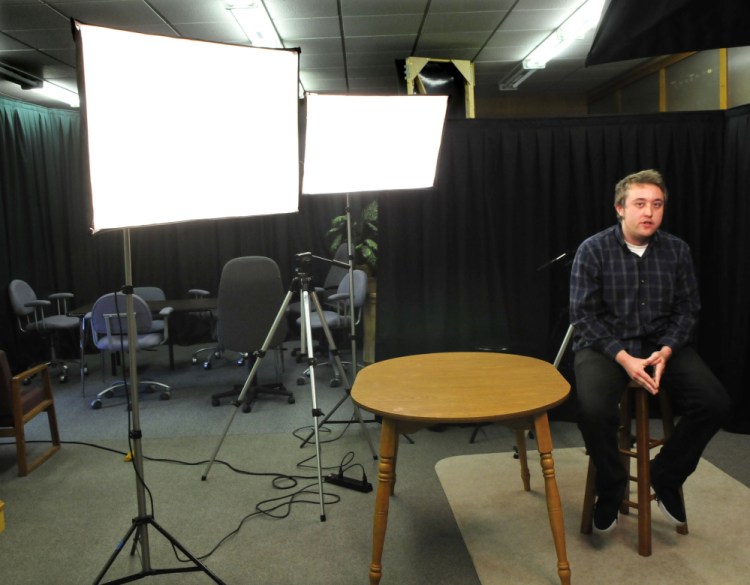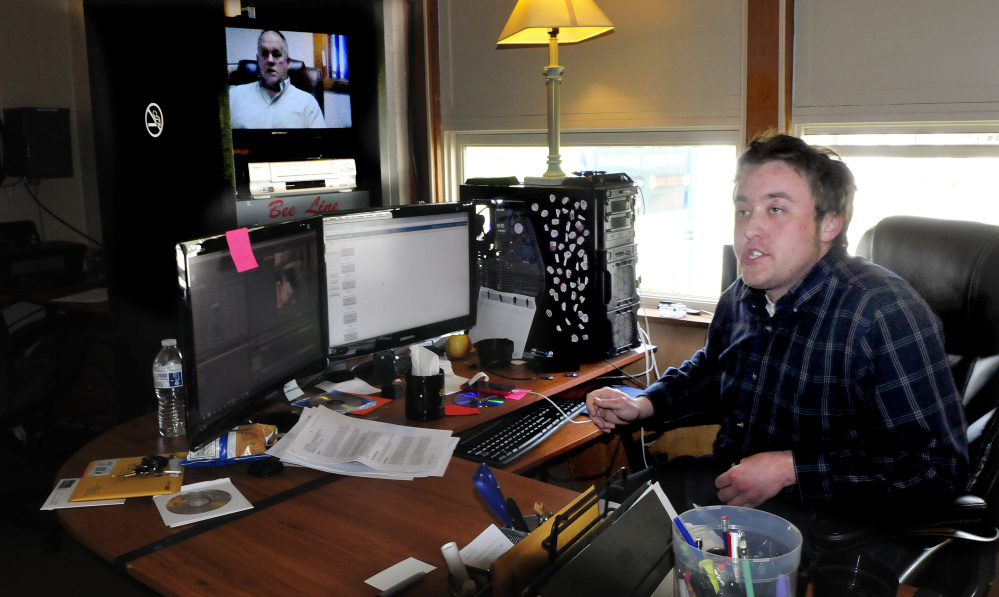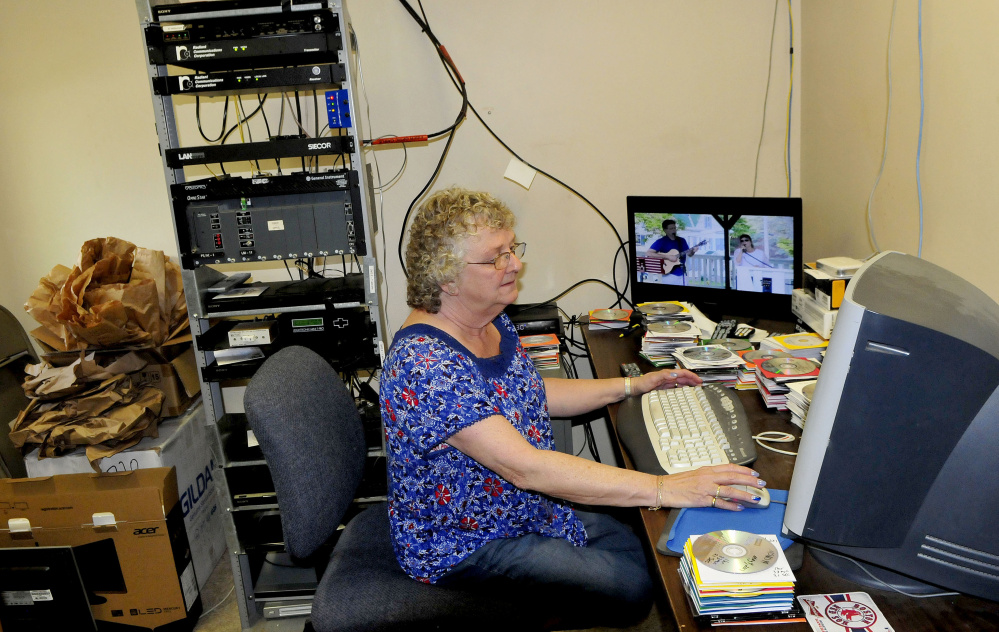MADISON — For John Harlow, staying home in Maine was always important.
Harlow, who graduated from the University of Maine Farmington in 2013 with a background in media studies, is the station director for Somerset Community TV 11, which was formerly known as Channel 11.
Harlow said that when he first came on board, the station, from its programming to its equipment, felt antiquated. It was airing funerals. Broadcasts were played from DVDs.
So Harlow, 27, changed things. The Athens resident, who also graduated from Madison Area Memorial High School, brought the studio into the digital age.
He diversified the programming to include more community oriented segments in addition to broadcasting Board of Selectmen meetings and town announcements.
Now, programming is downloaded onto a server.
“The physical space has changed since I’ve been here,” he said.
The station, which sits at 108 Old Point Ave. in Madison, consists of two rooms, a large studio space and a smaller office where Harlow edits video. He allocated a portion of the station’s budget to buy new lights and high definition digital cameras and microphones to modernize the studio set and increase overall production value.
The station, which Harlow said has been around since the early 2000s, serves three towns: Madison, Skowhegan and Anson. It has been rebranded as Somerset Community TV 11.
Harlow said the original name, Channel 11, was nondescript and didn’t set the station apart. He said branding was important to help the station stand out and separate it from the old station in the minds of viewers.
“The perception was it was an old folks channel,” he said.
Additionally, Somerset Community TV 11 is now a nonprofit organization, which Harlow said had been a long-term goal for the station and will help with sponsorships and securing donations in the future.
“It was a pretty big undertaking,” he said, adding later, “I think it’s succeeded a lot and grown a lot.”
Harlow believes becoming a nonprofit is a trend more successful stations are following. He points to Mt. Blue TV in Farmington as a sister station to his that is nonprofit and has made similar modernization efforts. Both nonprofit status and modernization may be key to the future for local access television as cable subscriptions trend downward and the internet offers other options online.
GOING BEYOND CABLE
Brian Knoblock, secretary of the Portland-based Community Television Association of Maine that assists more than 150 towns in Maine with their television channels, said public access television in the state varies. Some, like Somerset Community TV 11, are nonprofit organizations, but more often stations are run by local governments. Becoming a nonprofit is an individual station’s decision.
“Each example has its own story,” he said.
Knoblock said about 75 local access stations operate across the state. About 25 of them are members of CTAM, which provides them networking opportunities.
There’s no way to determine viewership for these stations, Knoblock said, as the cable companies that link them to their viewers only record the number of household subscriptions in their area, which means these channels only know the total number of potential viewers.
“Often we have no idea how many people are watching,” Knoblock said.
Harlow said the Somerset station reaches about 5,000 households. J.P. Fortier, director of Mt. Blue TV, said his station reaches about 1,300 subscribers in Farmington and Wilton.
Both channels are broadcast through the locally owned Bee Line Cable out of Madison and not through a larger company like Spectrum. Harlow said this has been really helpful, as it has allowed for a more personal connection to the company and greater convenience if his operation needs service.
Laura Guite, who runs Fairfield-based Central Maine Community Access TV, said her organization, which is carried by Spectrum, reaches between 15,000 and 20,000 households in Albion, Benton, China, Clinton, Fairfield, Oakland, Vassalboro, Waterville and Winslow.
Nationally however, Knoblock said the number of cable subscribers is shrinking as more and more people turn to the internet for what they want to watch. Following that trend, a number of stations are moving toward measurable ways of broadcasting, such as video streaming or on demand service on their websites, Knoblock said. Some are turning to social media platforms such as Facebook and YouTube, which can also tally viewership.
“People aren’t subscribing because they have other choices,” he said.
While Somerset TV and Mt. Blue TV are incorporating those other choices into their offerings, funding for the two stations along with Central Maine CATV is dependent in great part on franchise fees, annual fees local governments charge private cable television companies for access to rights-of-way for their network of wires.
Somerset Community TV 11 has an annual budget of $67,500. Harlow said that if future funding from cable subscriptions becomes less certain, the station has other avenues for funding, such as sponsorships and fundraising as a nonprofit.
Harlow said the station could also offer video services, such as loaning a person or company the station’s facilities and equipment to film a commercial.
Fortier said Mt. Blue TV gets about $80,000 in franchise fees, but that covers only 80 percent of the station’s total budget. The rest has to be made up through sponsorships and video production services.
Even with $80,000, Fortier said the station is “operating on a shoestring budget,” holding off spending where they can.
“It’s not getting any better, so we need to find another steady revenue stream that’s not going to change,” Fortier said, suggesting the possibility of a viewer support campaign.
For Laura Guite and her Fairfield-based operation, money is the big problem in what she calls her “antiquated world.”
BROADCAST LIMITS
Fairfield-based Central Maine Community Access TV runs a DVD-based system that only allows program content every other hour, so it works in two-hour slots. In the content breaks, the station scrolls slides of sponsors and advertisements.
Laura Guite, the station manager who runs the operation singlehandedly, said she would like to see more programming, but the station doesn’t have the capacity. She readily admits the station’s equipment is more antiquated than other local access stations’ equipment, which limits the variety of material that can be broadcast. The problem is money, she said. The station receives only a small amount of franchise fees from cable broadcaster Spectrum, and the balance has to be made up independently.
A year ago, the town of Fairfield settled for $125,000 a lawsuit with then Time Warner Cable over franchise fees. The lawsuit was filed in 2014 against the cable company for not paying enough in franchise fees, which the cable provider pays annually to use the town’s public right-of-ways and transmission lines.
Guite said the town used a portion of the settlement to pay off legal fees and kept the balance, which she said could have been put toward the station. She said the station needs $25,000 to upgrade to a digital system, which she said she had hoped would come from the settlement. She said the station’s overall budget is between $60,000 and $65,000, but only $20,000 was approved for the station at the annual Town Meeting earlier this month.
“I want more programming out there on the air,” Guite said.
The station’s cameras are so old, the companies that made them don’t make parts for them anymore. Once, when equipment broke down, she had to call around the state to get the parts. As it turned out, this was at the time Harlow was updating his equipment in Madison, so he donated parts to Guite. All told, the Fairfield-based station was crippled for three weeks, broadcasting only the bulletin board.
“Here we sit in this antiquated world,” Guite said.
Guite said the town and Town Council and station have not worked well together. The station broke away from the town in 2008, Guite said, and the town is now looking to start its own station, collaborating with colleges and other organizations.
“This station is working with a hostile council,” she said.
Fairfield Town Manager Michelle Flewelling said the town is exploring having a station that captures all three categories of public, educational and government access television, which local access stations are designed to provide. She said the town hopes to work with Central Maine CATV to explore that framework and build a plan.
For the past six months, Flewelling said, the town has been trying to partner with local educational institutions to “maintain and enhance current programming and expand programming throughout the region.”
Since Central Maine CATV is a separate entity from the town and a nonprofit, Flewelling said the station receives funding the same way another nonprofit would. The town has no oversight over the station’s finances, she said, and has never been asked to fully fund the station before.
“It’s always been that way,” Flewelling said, though she said she wasn’t sure why the agreement was set up that way.
TECHNOLOGY DRIVEN
Fortier, the station director for Mt. Blue TV, said his station has been fully digital and high definition for years now, and he and a part-time helper have turned to other platforms to reach more viewers. Mt. Blue TV now provides more online content, and Fortier likened it to Netflix in how it can be accessed and viewed. He said the station also streams live events, such as local sports games, even posting them to Facebook for people to watch. A recent concert at the University of Maine Farmington had more than 1,800 views the night it happened.
“It used to be only cable subscribers could watch,” he said. “Now anybody, anywhere, anytime can get our programming.”
Somerset TV has a wide range of broadcasts, Harlow said. It airs local worship services, the Planning Board and Board of Selectmen meetings for its towns, in-house produced programs, local sports events and musical performances. Harlow said the programming today is more diverse than when he first took over the station. In addition to local programming the station produces, documentaries and old videos of what the area used to be like have aired, movies available from the public domain have been run and local events have been broadcast.
Harlow said the station has aimed its website and Facebook page toward a younger audience with short segments about things going on in the area uploaded directly online.
“The channel will always be available to everybody, but the website and the Facebook page are geared to a younger audience,” he said.
Skowhegan resident Derek Ellis said he doesn’t get the channel where he lives, but he asks his father to record everything related to local government so he can go back and watch it.
Ellis, the park resource manager at Lake George Regional Park, said he thinks the channel is valuable because it’s a way to stay caught up on what’s going on in the area. In addition to keeping up with local government, Ellis said it also allows him to see programs about different people or places in the community. Even though he considers himself active in the community, Ellis said sometimes he just can’t make it to a Board of Selectmen meeting, but Somerset Community TV allows him to remain in the loop.
“I primarily use it as a tool to keep up with local government,” he said.
The station runs 24/7, Harlow said, every day of the year. A selection of programs runs at specific times, and Harlow decides what fills the remaining hours. The station is not always staffed, he said, because he and his crew of three often go out into the community.
Through it all, Harlow, the son of Morning Sentinel reporter Doug Harlow, said he’s reminded of the importance of being a young person in central Maine, as the area has seen its “ups and downs.”
Harlow hopes his story inspires a younger generation to stay in central Maine and find work rather than move away. Living here and working at the station has given him the opportunity to see something grow. He said he would soon be participating in career fairs at local schools to show students they don’t have to move away to get a job in a field like his.
“It’s important to me to be a positive force in the community, where I see a lot of young people leaving, and trying to do something good for central Maine,” Harlow said.
Colin Ellis — 861-9253
cellis@centralmaine.com
Twitter: @colinoellis
Send questions/comments to the editors.






Success. Please wait for the page to reload. If the page does not reload within 5 seconds, please refresh the page.
Enter your email and password to access comments.
Hi, to comment on stories you must . This profile is in addition to your subscription and website login.
Already have a commenting profile? .
Invalid username/password.
Please check your email to confirm and complete your registration.
Only subscribers are eligible to post comments. Please subscribe or login first for digital access. Here’s why.
Use the form below to reset your password. When you've submitted your account email, we will send an email with a reset code.